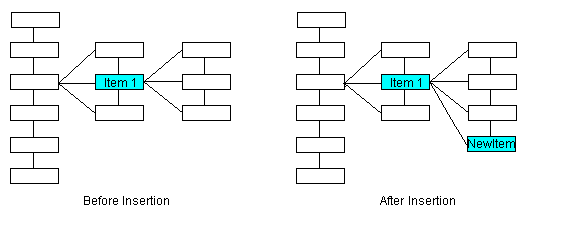
|
Products | Support | Email a link to this topic. | Send comments on this topic. | Back to Introduction - All Topics | Help Version 19.0.3.25
|

|
Products | Support | Email a link to this topic. | Send comments on this topic. | Back to Introduction - All Topics | Help Version 19.0.3.25
|
| Leadtools.Dicom Namespace > DicomDataSet Class : InsertElement Method |
A sequence may consist of one or more items. This parameter lets you insert a data element as any item within the sequence, not just at the end. In addition, it lets you insert multiple data elements within a sequence.
If neighbor points to the parent of a sequence and child is true, the index will pertain to the children of neighbor. If neighbor points to a member of a sequence and child is false, the index pertains to the siblings of neighbor.
public DicomElement InsertElement( DicomElement neighbor, bool child, long tag, DicomVRType vr, bool sequence, int index )
'Declaration
Public Function InsertElement( _ ByVal neighbor As DicomElement, _ ByVal child As Boolean, _ ByVal tag As Long, _ ByVal vr As DicomVRType, _ ByVal sequence As Boolean, _ ByVal index As Integer _ ) As DicomElement
'Usage
Dim instance As DicomDataSet Dim neighbor As DicomElement Dim child As Boolean Dim tag As Long Dim vr As DicomVRType Dim sequence As Boolean Dim index As Integer Dim value As DicomElement value = instance.InsertElement(neighbor, child, tag, vr, sequence, index)
public DicomElement InsertElement( DicomElement neighbor, bool child, long tag, DicomVRType vr, bool sequence, int index )
public DicomElement insertElement(DicomElement neighbor, boolean child, long tag, DicomVrType vr, boolean sequence, int index )
function Leadtools.Dicom.DicomDataSet.InsertElement( neighbor , child , tag , vr , sequence , index )
public: DicomElement^ InsertElement( DicomElement^ neighbor, bool child, int64 tag, DicomVRType vr, bool sequence, int index )
A sequence may consist of one or more items. This parameter lets you insert a data element as any item within the sequence, not just at the end. In addition, it lets you insert multiple data elements within a sequence.
If neighbor points to the parent of a sequence and child is true, the index will pertain to the children of neighbor. If neighbor points to a member of a sequence and child is false, the index pertains to the siblings of neighbor.
For the sake of these illustrations, the order of siblings is top to bottom. Therefore, since added items become the last sibling or the last child, these are drawn at the bottom of the appropriate group of items.
In this illustration, neighbor points to Item 1 and child is false. The new item is added as the last sibling of Item 1.

In this illustration, neighbor points to Item 1 and child is true. The new item is added as the last child of Item 1.
